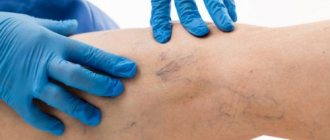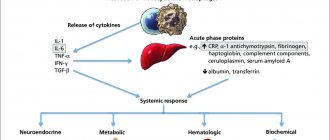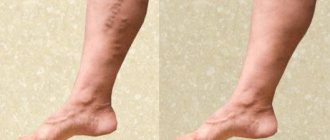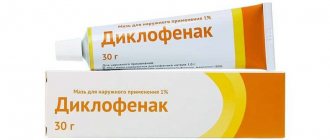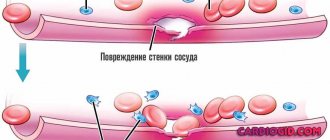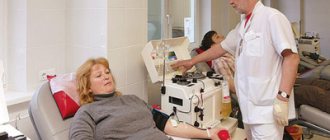Varicose veins in the groin in men are a common consequence of negative conditions characteristic of the modern lifestyle. They invariably lead to the emergence of various cardiovascular pathologies. Damage to the vessels of the lower extremities is more common, but varicose veins in the groin in men are a consequence of the same vicious sequence of disorders. The reasons for their occurrence are the formation of stagnation, deformation of venous valves and vascular walls, and the lack of physiological outflow of blood.
Causes
Inguinal varicose veins are a scourge of any age category that can develop during puberty. If neglected, it can cause irreversible consequences, and delayed seeking medical help complicates the process of treating varicose veins in the inguinal veins in men.
In the early stages of the disease, it could be eliminated without any problems, but in the later stages it is a long process that requires an integrated approach to treatment.
It is difficult to determine a separate reason for the development of vascular disorders. This is usually a consequence of pathological changes in normal blood flow, progressing under the influence of negative external and internal conditions.
The causes of the appearance of varicose nodes in the groin area are called dysfunctions of various etiologies. Such pathologies are associated in men with many factors: from youthful masturbation and Viagra in old age, to a sedentary lifestyle and intense sports.
Very often, it is office workers, cooks, waiters, hairdressers, pharmacists, teachers, loaders, and other general workers who turn to the doctor with the problem of varicose veins.
Treatment of inguinal varicose veins in men is urgently necessary, because otherwise the progression of the condition leads to the need for surgical intervention.
Varicose veins in the groin of women can develop during pregnancy, as a result of pressure from the enlarged uterus with the fetus, or squeezing of blood vessels. In men, varicose veins in the groin can develop for other reasons.
The most common of them include:
- hereditary anomalies in the structure of blood vessels or genital organs;
- problems with sexual activity (masturbation, taking stimulants, prolonged absence of sexual intercourse, artificially prolonging its duration);
- intense loads during systematic sports or in gyms;
- heavy physical work associated with lifting and moving heavy objects;
- sedentary lifestyle, hemorrhoids, stool disorders associated with it (pathological constipation and diarrhea);
- injuries to the groin area (penis):
- chronic infectious and inflammatory processes in the reproductive system;
- hormonal imbalances (excess or deficiency of male sex hormones);
- vascular atherosclerosis and excess weight associated with poor nutrition and bad habits;
- oncological tumors or hernias.
The appearance of varicose veins in the groin in men can also develop against the background of a combined effect of causes that contribute to a more rapid progression of the pathology. The symptoms of varicose veins in the groin in men depend on the location of the lesion and the degree of its development.
Treatment tactics are determined by the symptoms that appear: at an early stage they are practically invisible and are ignored by most patients. The longer treatment is delayed, the more difficult it is to eliminate the consequences and normalize the patient’s condition.
Symptoms that can help determine the development of the disease
At first, varicose veins in the groin do not manifest themselves in any way. However, further, with the constant progression of the disease, men may observe protruding veins in the area of the penis and scrotum, and pain may also occur when urinating in a standing position. An additional symptom is pain during erection.
In women, the disease manifests itself as unpleasant sensations in the genital area. In addition, pain is also felt, itching, irritation appears, and sometimes it can pull in the lower abdomen.
Note!
As soon as you notice protruding veins in the genital area or anywhere else, do not ignore it, but immediately go to a specialist and solve the problem in a timely manner. This way you will protect yourself from complications that may result from surgery.
Diagnostics
To diagnose varicose veins, the doctor does:
- survey;
- examination of the patient;
- after which he palpates the affected areas of the body.
If palpation does not produce results and the doctor cannot determine the presence or absence of deformed veins (varicose veins are too deep), the patient is recommended to undergo Doppler ultrasound. Thanks to this procedure, it is possible to determine the condition of blood vessels using ultrasound in a certain area.
In addition to Doppler ultrasound, doctors may recommend angiography. During this procedure, the patient is injected with a special contrast agent into a vein, which makes it possible to identify the veins most affected by varicose veins during radiography.
Classification of inguinal varicose veins
Varicose veins in the groin in men are differentiated according to several criteria; the main principles of differentiation are dislocation and degree of development. It is rarely distinguished by etiology (except in cases of hereditary anomalies), because it is simply impossible to determine the true cause.
There are two types based on location: varicose veins in the inguinal veins or in the scrotum; testicular lesions, called varicoceles, are considered separately.
There are 4 stages of inguinal varicose veins in men:
- hidden, when the symptoms are vague and diagnosis is possible only by ultrasound;
- manifested in the form of deformation of the veins, noticeable even when standing;
- stage of development, when negative venous formations are visualized and pain symptoms increase;
- dangerous, fraught with complications, worsening a person’s condition, with the appearance of lumps and nodes localized in the swollen area.
Varicose veins in the groin can progress according to an individual scenario. Despite the possibility of distinguishing between stages of the disease, the speed of its development and the duration of each stage are very difficult to predict. This can last for several years, or occur with high intensity, depending on the subclinical picture of the individual patient and additional provoking factors.
Varicose veins of the perineum (in an intimate place)
Varicose veins of the labia and legs during pregnancy are similar not only in treatment methods, but also in the causes of formation. Often this pathology occurs due to hormonal disorders or heredity. The photo shows what this disease looks like during pregnancy.
The pathology causes severe discomfort. Women worry about how to give birth and what to do if complications arise during pregnancy. Regardless of whether the veins are swollen on the right side of the perineum or on the left, the sensation is terrible.
The skin becomes very dry, irritated, and the slightest touch to it causes itching and burning. The perineum may become less sensitive, sore and constantly itchy. These symptoms greatly torment the woman.
Often there is a frequent urge to urinate and urinary incontinence. Pain occurs after sexual intercourse, visiting the toilet and physical activity.
Discomfort in swollen tissues often radiates to the sacrum, which causes severe pain. As a result, the woman becomes irritable and her mood deteriorates. After all, even during pregnancy you want to look beautiful and feel cheerful.
If you find out about the presence of varicose veins in the pelvis or vagina, but do not take any action, the condition will worsen. It will become difficult for a woman to walk and sit, and any movement will begin to cause inconvenience. Therefore, you need to urgently go to the doctor, and not try to be treated using photos and advice from forums.
More joy and love
Symptoms in men and women
Symptoms of varicose veins in the groin in men and the signs accompanying the development of inguinal varicose veins in women are approximately similar, especially when you consider that the structure of the reproductive organs is different, and the causes can be radically different.
The manifestation of painful symptoms of varicose veins in the groin in women increases with greater intensity if the disease is provoked by pregnancy. Such sensations intensify as the fetus and uterus grow.
Let's look at the comparison table:
| Stage | First | Second | Third | Fourth |
| Male varicose veins | Almost imperceptibly, determined only by hardware testing. | Feeling of discomfort, swollen veins, testicular deformation (with HPV). | Permanent pain symptom, compactions under the dermal layer, venous nodes, swelling of the groin area. | Venous lumps and swellings, difficulty walking, potential for blood clots. |
| Female varicose veins | Nagging pain in the lower abdomen, spontaneous and quickly passing. | Increasing pain symptoms, discomfort during sexual intercourse. | The appearance of vascular anomalies, stars and bumps, noticeable even in a calm state, itching in the genitals. | Constant discomfort, pain, itching, bumps and bumps increase in size, the prognosis of complications increases significantly. |
Is this disease dangerous?
Absolutely yes. In addition to the unpleasant symptoms that characterize this disease, the disease poses a real threat to the health and life of a woman.
Thus, a blood clot formed in a vein can break off and begin to move freely through the circulatory system. And this, in turn, can lead to attacks of suffocation, and, in especially severe cases, to death.
And the sooner the better, because despite the mild symptoms, vaginal varicose veins are a very dangerous disease. And timely treatment will reduce the risk of dire consequences, help get rid of unpleasant symptoms, and improve the quality of life.
The problem with dilated veins in the legs in women most often occurs during pregnancy and the birth of a child. Varicose veins after childbirth make you see a doctor, because the expansion, tortuosity and thickening of the veins in the groin and legs look extremely unsightly. This is especially true for young girls who have given birth to their first child and have lost some of their natural beauty. The main causes of the disease are explained by the increased load on the blood vessels, and the symptoms are so typical that it will not be difficult for a doctor to make a diagnosis. Varicose veins should be treated under the supervision of a phlebologist, strictly and consistently following the doctor’s recommendations.
Diagnostics
The main diagnostic methods are palpation, external examination, anamnesis and medical history. Laboratory research is carried out in several areas:
- according to the state of urine;
- A general blood test is taken (shows the condition of the body and the presence of inflammatory processes).
The doctor may prescribe duplex scanning, CT, Dopplerography, angiography as additional methods if the venous nodes are located unusually deep and it is impossible to get an idea of them during a visual examination. Sometimes they are prescribed when laboratory tests indicate the possibility of blood clots.
Prevention
An important condition for prevention is making lifestyle adjustments. It is advised to review your diet and choose the optimal physical activity for yourself (running, swimming, walking).
Preventive measures against this disease in men:
- balanced diet;
- regular sex life;
- quitting smoking and alcoholic beverages.
Prevention for women is:
- normalization of working conditions - mandatory exclusion of heavy physical activity;
- daily walks in the fresh air, gymnastics;
- proper nutrition - preference should be given to fruits and vegetables, trying to eat less meat dishes;
- daily contrast shower.
Varicose veins require close attention to your own health and an appropriate attitude. This is adherence to a healthy lifestyle and nutrition, timely treatment and maintenance of normal condition. Varicose veins cannot be cured completely, but by following all the doctor’s recommendations and prevention against this disease, you can stop its progression for a long time.
Treatment
Varicose veins in the groin are a consequence of systemic disorders in the body; a violation of venous outflow does not appear in every person, even if he works hard or plays intense sports.
Treatment of varicose veins in the groin in women is often complicated by pregnancy, when the use of medications can pose a potential danger to the fetus. In addition, after childbirth, the pressure on the blood vessels will disappear.
For men, two tactics are used:
- conservative;
- operational.
In any case, a comprehensive method is used, which involves medications, physiotherapy and diet therapy, lifestyle changes and folk recipes.
Medication
In the early stages, venotonics and anticoagulants are prescribed to improve the condition of blood vessels and prevent venous stagnation. For severe pain, non-narcotic analgesics are recommended; in the presence of an inflammatory process, non-steroidal anti-inflammatory drugs are recommended. The type of drug and its dosage is determined by the doctor.
Taking medications is allowed only after the appointment of a phlebologist or urologist.
Lifestyle
The patient is recommended to radically change his lifestyle - get rid of bad habits, change his occupation, normalize and regulate his diet, temporarily stop sexual intercourse, and resort to wearing compression garments.
Operation
Surgery is considered the optimal method in the final stages. It can be carried out in the traditional way (for large formations), or using minimally invasive methods - scleroplasty, laser coagulation.
Folk recipes
In this case, folk recipes come down to compresses with decoctions of medicinal plants or the use of homemade ointments. Anti-inflammatory or restorative tinctures are taken internally, infusions are prepared (on birch mushroom), alcohol tinctures are taken orally and used to lubricate the affected areas.
Varicose veins in the groin during pregnancy and childbirth
If the damage to the external genitalia is severe, the woman is hospitalized in the hospital at the 38th week of pregnancy and, after a thorough examination, the method of resolving labor is determined. In cases of extensive varicose veins, in order to avoid rupture of dilated vessels and dangerous bleeding, doctors have to prescribe delivery by cesarean section.
However, whenever possible, preference is always given to natural delivery. In this case, in order to prevent the backflow of blood during labor, the woman is wearing special compression stockings.
Complications
The main danger posed by varicose veins in the inguinal veins is venous insufficiency. It can lead to the development of an inflammatory process and dysfunction of the affected organ, or to the formation of a blood clot that clogs the lumen of the vessel and can even cause death.
[addtoany] Related Articles
Symptoms and treatment of varicose veins of the uterus
Varicose veins of the penis - what is this disease and why is it dangerous?
Characteristics of reticular varicose veins
Add a comment Cancel reply
